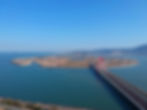Shanghai Jiao Tong University Engineers Design World's First Nuclear-Blast-Resistant Floating Artificial Island
- MM24 News Desk
- 2 days ago
- 3 min read

Shanghai Jiao Tong University researchers are leading the design of a 78,000-tonne floating artificial island engineered to withstand nuclear blasts, a world-first for a mobile deep-sea platform. The massive facility, scheduled for completion in 2028, will house 238 occupants for up to four months without resupply, enabling unprecedented long-term scientific missions in contested ocean regions.
Imagine a massive, mobile scientific base capable of riding out a typhoon—or even a nuclear explosion—while supporting hundreds of researchers in the middle of the ocean for months on end. This isn't science fiction; it's a project underway in China that promises to redefine maritime presence and deep-sea exploration.
The "Deep-Sea All-Weather Resident Floating Research Facility" combines the permanence of an island with the mobility of a ship, all protected by revolutionary shock-absorbing materials.
Led by Professor Yang Deqing from Shanghai Jiao Tong University (SJTU), the team has designed a semi-submersible, twin-hull platform with a displacement rivaling the Chinese navy's newest aircraft carrier. In a peer-reviewed paper published in the Chinese Journal of Ship Research, the researchers revealed the facility's most startling feature: a nuclear-blast-resistant design.
"Its superstructure contains critical compartments that ensure emergency power, communications and navigation control – making nuclear blast protection for these spaces absolutely vital," wrote he team, according to their published research.
The need for such extreme protection in a civilian research facility raises questions about its intended operating environments, which potentially include disputed zones like the South China Sea. While officially a scientific platform, its design references GJB 1060.1-1991, a Chinese military specification for nuclear blast resistance. This dual-purpose nature underscores the project's strategic significance as China expands its blue-water capabilities.
The breakthrough enabling this resilience lies in a sophisticated "metamaterial" sandwich panel. Traditional nuclear blast protection relies on impossibly thick and heavy steel plates, but Professor Yang's team developed a three-dimensional "negative Poisson's ratio" corrugated tube structure.
This ingenious design works like a high-tech crumple zone for a nuclear shockwave. When the blast hits, the microscopic lattice of folded metal tubes collapses in a controlled, sequential manner, spreading the catastrophic instant impact into a gentle, manageable squeeze over time.
Through thousands of computer simulations, the researchers optimized the design to a sweet spot: tubes with a 21.25-degree angle and 0.6-mm wall thickness. The result is astonishing—a sandwich panel just 60mm (2.4 inches) thick that outperforms much heavier conventional armor.
Under simulated nuclear blast conditions, this metamaterial bulkhead reduced maximum displacement by 58.53 percent and peak stress by 14.25 percent, all while weighing slightly less than traditional protection.
"The facility's potential applications could extend far beyond pure research," noted the analysis, suggesting it could serve as a resilient command node or surveillance station. Its 120-day endurance without resupply exceeds that of many nuclear-powered aircraft carriers, offering persistent presence in remote areas. Unlike fixed artificial islands, which are diplomatically contentious, this mobile platform can deploy to contested waters for research and then relocate as situations evolve.
"We're racing to complete the design and construction, aiming for operational status by 2028," said Lin Zhongqin, an academician leading the project, in an earlier interview. The facility promises to become a "paradigm shift" in ocean science, offering real-scale testing capabilities that no laboratory or existing ship can match.
As global competition for maritime resources intensifies, this nuclear-hardened floating island represents not just a scientific achievement, but a trategic asset that could alter the balance of power in the world's oceans.